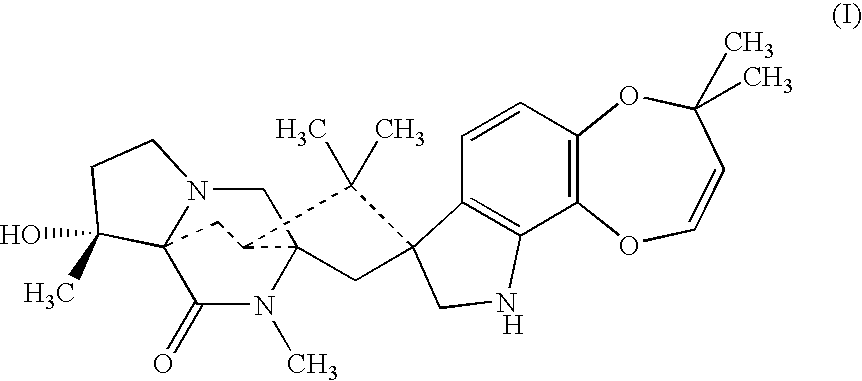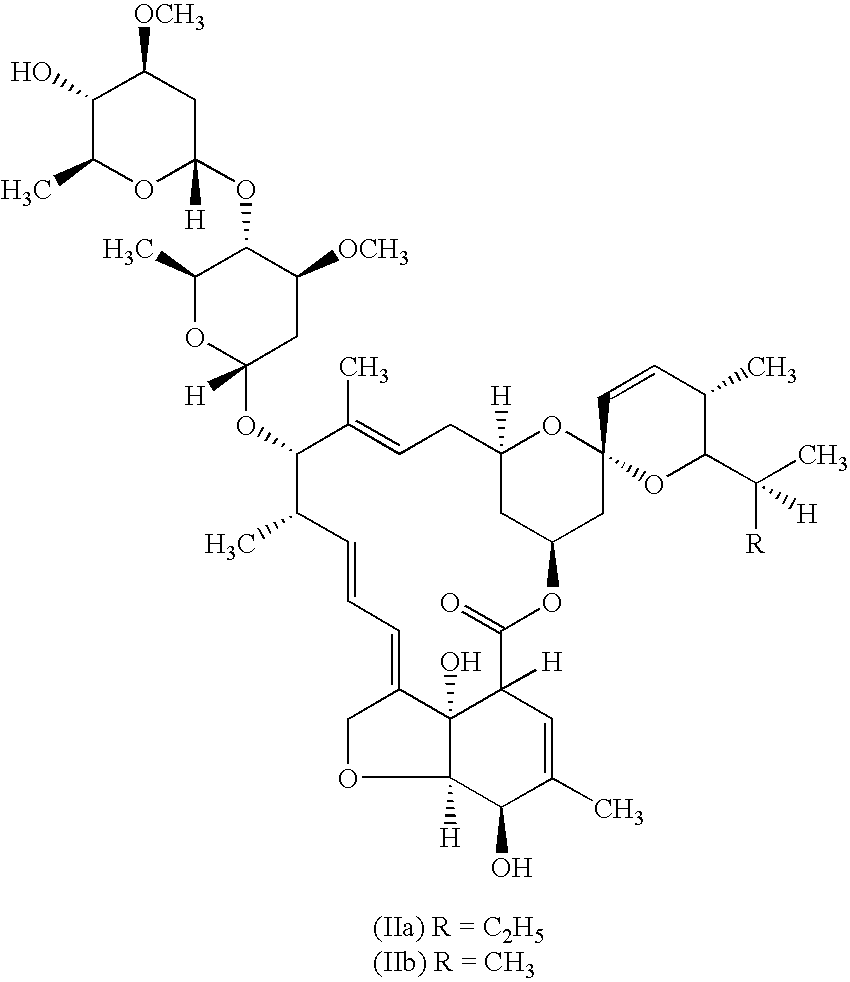Anthelmintic combination
a technology of antihelmintic and anti-parasitic agents, applied in the direction of antiparasitic agents, biocide, drug compositions, etc., can solve the problems of parasite resistance, limited activity spectrum, repeated treatment, etc., and achieve the effect of reducing the frequency of macrocyclic lactone-resistant individuals
- Summary
- Abstract
- Description
- Claims
- Application Information
AI Technical Summary
Benefits of technology
Problems solved by technology
Method used
Image
Examples
example 1
[0047]The efficacy of the combination is demonstrated in the following trial.
[0048]Fifty four (54) sheep (Merino whether hoggets) were assigned at random to one of nine groups. At day -41 of the trial the sheep were treated with naphthalaphos and levamisole to remove any pre-existing parasite burden. Faecal samples were collected at day -27 of the trial and analysed to confirm parasite eradication. On day -24 the sheep were infected by intra-ruminal injection with the following parasites:[0049]ca. 3000 3rd stage (L3) Kirby susceptible strain Haemonchus contortus [0050]ca. 6000 3rd stage (L3) McMaster susceptible strain Teladorsagia circumcincta [0051]ca. 6000 3rd stage (L3) McMaster susceptible strain Trichostrongylus colubriformis
[0052]Faecal samples were collected on day -1 of the trial and egg counts were determined.
[0053]On day 0 of the trial, the sheep were treated according to the following schedule.
[0054]
Number ofDose ofDose ofGroupanimalsFormulation2-DOPH*ABA*G16No treatmen...
example 2
The Treatment of Resistant Strains of Gastrointestinal Parasites in Sheep
[0060]Sheep were artificially infected with L3 larvae of Teladorsagia (Ostertagia) circumcincta and Trichostrongylus colubriformis and efficacy was measured by total worm counts in the treatment group compared to the control group following administration of treatment. The animals were treated as outlined below with the commercially available reference products included to confirm the resistance profile of the above parasites.
[0061]
Trt.DoseTrt.No. ofGrp.Test / Reference ItemRateDose VolumeRouteFreq.DayAnimalsT01Placebo (tap water)N / A0.20 mL / kgPer osOnceDay 010T022-DOPH 2 mg / kg0.20 mL / kgPer osOnceDay 010plus Abamectin0.2 mg / kgT03Albendazole3.8 mg / kg0.15 mL / kgPer osOnceDay 010T04Levamisole 8 mg / kg0.20 mL / kgPer osOnceDay 010T05Ivermectin0.2 mg / kg0.25 mL / kgPer osOnceDay 010
[0062]All study animals were necropsied on Day 15 after treatment. Abomasa and small intestines were collected for worm recovery and total worm ...
example 3
The Treatment of Resistant Strains of Gastrointestinal Parasites in Sheep
[0065]Sheep were artificially infected with infective L3 larvae in a mixed culture containing Haemonchus contortus, Teladorsagia spp and Trichostrongylus spp, and efficacy was measured by total worm counts in the treatment group compared to the control group following administration of treatment. The animals were treated as outlined below with the commercially available reference products included to confirm the resistance profile of the above parasites.
[0066]
Trt.DoseDoseTrt.No.Grp.Test / Reference ItemRateVolumeRouteFreq.DayAnimalsT01Placebo (tap water)N / A 0.2 mL / kgPer osOnceDay 010T022-DOPH 2 mg / kg 0.2 mL / kgPer osOnceDay 010plus Abamectin0.2 mg / kgT03Albendazole3.8 mg / kg0.15 mL / kgPer osOnceDay 010T04Levamisole 8 mg / kg0.20 mL / kgPer osOnceDay 010T05Ivermectin0.2 mg / kg0.25 mL / kgPer osOnceDay 010
[0067]All study animals were necropsied on Day 15 after treatment. Abomasa and small intestines were collected for worm ...
PUM
| Property | Measurement | Unit |
|---|---|---|
| transmission | aaaaa | aaaaa |
| resistance | aaaaa | aaaaa |
| anthelmintic compositions | aaaaa | aaaaa |
Abstract
Description
Claims
Application Information
 Login to View More
Login to View More - R&D
- Intellectual Property
- Life Sciences
- Materials
- Tech Scout
- Unparalleled Data Quality
- Higher Quality Content
- 60% Fewer Hallucinations
Browse by: Latest US Patents, China's latest patents, Technical Efficacy Thesaurus, Application Domain, Technology Topic, Popular Technical Reports.
© 2025 PatSnap. All rights reserved.Legal|Privacy policy|Modern Slavery Act Transparency Statement|Sitemap|About US| Contact US: help@patsnap.com


